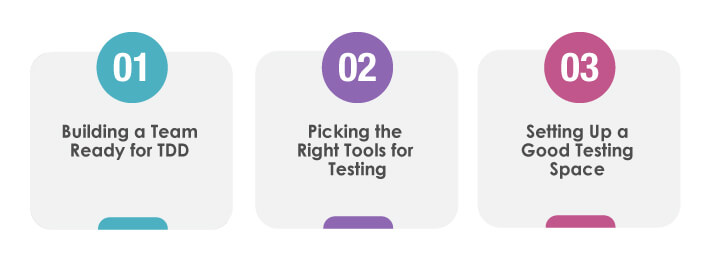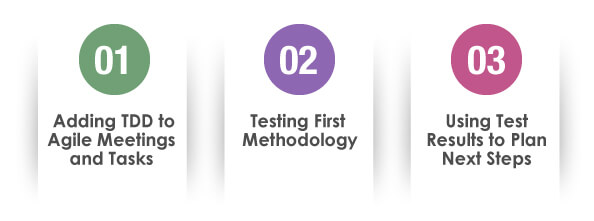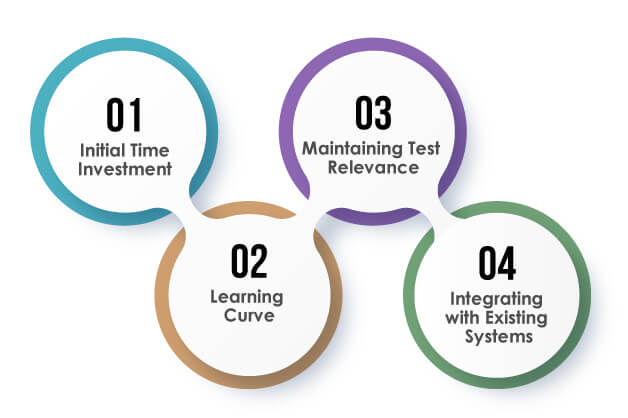
- What is Agile and Test-Drive Development?
- Starting with Test-Driven Development in Agile
- Aligning TDD with Agile Processes
- Best Practices for TDD in Agile Methodologies
- Addressing Challenges in TDD-Agile Integration
- Conclusion
- How Can TestingXperts Help with Software Testing?
In today’s rapidly changing software development and testing landscape, organizations constantly look for methodologies that streamline processes and enhance product quality. Agile and Test-Driven Development (TDD) have individually proven their ability to improve software quality and ensure faster time-to-market. Ideal for businesses, the guide highlights the integral role of TDD in Agile environments, contributing to a standard of excellence in software development.
What is Agile and Test-Drive Development?
Agile is a set of principles for software development where requirements and solutions evolve through the collaborative efforts of cross-functional teams. It involves adaptive planning, evolutionary development, early delivery, and continuous improvement, providing a flexible approach to responding to change.
On the other hand, TDD is a software development technique where developers first write tests for a new feature before writing the actual code. Agile and Test-Driven Development (TDD) are effective on their own, but when used together, they work even better and bring more benefits. Here’s why:

• With TDD’s continuous testing approach embedded in Agile iterative development cycles, each component is systematically verified, leading to robust software builds.
• Agile feedback-driven approach paired with TDD ensures that discrepancies are caught and rectified early, reducing backlogs and rework.
• Studies suggest that projects leveraging TDD within Agile methodologies see a notable reduction in post-deployment bugs.
Starting with Test-Driven Development in Agile
Integrating test-driven development within an agile framework is a strategic move that enables enhanced software quality and more efficient development cycles. However, one must approach the integration with clarity, preparation, and a keen understanding of both methodologies to reap these benefits.

Building a Team Ready for TDD
Ensure every team member understands the principles of TDD and its importance in Agile. Encourage team members to think about test cases before diving into code. Developers, testers, and business analysts should work closely, discussing requirements and test scenarios. It ensures everyone is on the same page and reduces misunderstandings.
Picking the Right Tools for Testing
There are many testing tools options available online. Consider the language compatibility, integration capabilities, and user feedback before deciding. Select tools that adapt to the project’s changing needs. Ensure that the testing tool seamlessly integrates with other tools in the development cycle, such as continuous integration servers and version control systems. It promotes a smoother workflow.
Setting Up a Good Testing Space
It’s crucial to have a separate, dedicated environment for testing. This ensures that tests don’t interfere with ongoing development and that the testing conditions remain consistent. While manual testing is necessary, look for opportunities to automate repetitive tasks. Automated tests save time in the long run and ensure that previously developed features work as intended after new changes. Make sure developers receive prompt feedback after tests. It allows them to address any issues quickly and maintains the agile continuous improvement cycle.
Aligning TDD with Agile Processes
Integrating test-driven development with agile processes can elevate the precision and predictability of software projects. This section explores the integration of TDD with Agile practices, emphasizing a unified approach that drives excellence at every phase.

Adding TDD to Agile Meetings and Tasks
Tests written and their outcomes should also be highlighted in the standup discussions. It ensures that testing remains central to daily operations and enhances accountability. When breaking down user stories into tasks during sprint planning meetings, it’s essential to incorporate tasks related to writing tests. It ensures that testing is integrated seamlessly into the development process. In sprint retrospectives, along with reviewing what went well and potential improvements, the outcomes of the tests should be examined. Evaluating the efficacy of these tests and determining necessary modifications for the next sprint can be beneficial.
Testing First
What It Means and Why It Helps – Adopting a testing-first methodology means formulating tests before developing the code. This approach sets clear benchmarks for code performance, thereby reducing ambiguities. After creating the code, it’s immediately evaluated against the predefined tests. Such a procedure offers instant feedback, enabling developers to refine the code promptly and bolsters code quality. By prioritizing testing, the chances of overlooking errors can be prevented. A robust foundation is maintained as development ensues since each code segment undergoes rigorous testing from inception.
Using Test Results to Plan Next Steps
Test outcomes have tangible data, shedding light on which facets of the project are progressing optimally and which require further scrutiny. Such a data-centric approach guarantees more effective task prioritization. Recurring test failures or unexpected results are early indicators of potential issues, allowing teams to resolve challenges much faster.
Best Practices for TDD in Agile Methodologies
Using Test-Driven Development within Agile methodologies offers a way to achieve optimal software performance. To fully implement this integration, certain best practices are necessary. Let us look into these practices, outlining a roadmap to combine Agile and TDD successfully.

Writing Clear and Simple Tests
Test cases should be easy to understand. It means that any team member, whether a developer or a tester, can quickly grasp the test’s purpose and the expected outcome. Establishing a consistent naming convention for tests helps quickly identify what specific functionality a test covers.
Combining Different Types of Tests
In a complex software project, relying solely on one type of test can leave gaps. It’s essential to use a combination of unit, integration, and system tests to ensure comprehensive coverage. While all tests are crucial, unit tests might be more frequent due to their focus on individual components. However, integration and system tests should also be scheduled regularly to ensure the software functions as expected.
Testing Together and Learning from Each Other
Occasionally, developers and testers should pair up to write tests. This practice encourages knowledge sharing and brings different perspectives, often leading to more robust tests. After testing sessions, it’s beneficial to have feedback rounds where team members share insights, challenges, and learnings. It ensures continuous improvement in the testing process.
Stay Updated, Analyze, and Refine
Software and testing landscapes always change. Regularly investing time in training and exploring new testing tools and methodologies can elevate the team’s testing proficiency. After each iteration, review the testing process. Identify areas of success and those that need adjustments. Implementing these insights in subsequent sprints ensures constant evolution and optimization.
Keeping the Focus on What Customers Need
While technical perfection is vital, tests should always meet customer requirements. It means prioritizing tests that focus on features and functionalities most valuable to end-users. Gather feedback from actual users and incorporate this into the testing strategy. This ensures the product functions flawlessly and aligns closely with user expectations and needs.
Addressing Challenges in TDD-Agile Integration
While integrating Test-Driven Development (TDD) with Agile methodologies promises a full combination for software development, it is not without its challenges. Recognizing and addressing these challenges head-on can pave the way for smoother operations and enhanced outcomes. This section illuminates common obstacles faced during TDD-Agile integration and provides actionable tips to navigate them.

Common Challenges and How to Overcome Them
Initial Time Investment
Implementing TDD requires writing tests before actual development begins, which can seem time-consuming initially. Some businesses might view this as a slow development pace, especially during tight deadlines. While TDD might seem time-intensive initially, it leads to fewer errors and more robust software in the long run. It’s crucial to highlight these long-term benefits to the team to keep them invested.
Learning Curve
For teams new to TDD, there’s a learning curve associated with understanding and implementing effective tests. It could lead to potential inefficiencies until the team becomes proficient. To address the TDD learning curve, periodic training sessions can be organized. This helps familiarize the team with best practices and accelerates the adoption process.
Maintaining Test Relevance
Ensuring that tests remain relevant can be challenging as projects evolve. There might be scenarios where tests written early no longer align with the project’s current requirements. To ensure test relevance, schedule regular reviews of the tests. Out-dated tests can be identified and updated during these sessions, ensuring they align with the project’s evolving requirements.
Integrating with Existing Systems
For projects that had begun without TDD or with a different testing methodology, integrating TDD midway can pose compatibility and consistency challenges. For projects adopting TDD midway, consider a staged integration instead of a complete rebuild. Start by introducing TDD in specific modules or components. Expand its scope across the project as the team gains confidence and proficiency.
Conclusion
Combining Agile and Test-Driven Development (TDD) offers a robust framework for software development. It’s crucial to maintain a commitment to best practices and strongly emphasize continuous learning and improvement. By implementing robust test-driven development approach, businesses can optimize processes and products, ensuring quality and efficiency in every project.
How Can TestingXperts Help with Software Testing?
At TestingXperts, we use our vast experience with the latest testing methodologies to work with precision and exceed client expectations. Partnering with us means securing a competitive edge, minimizing risks, and optimizing software performance and reliability. We combine test-driven development with quality assurance, ensuring your software is always ahead of the competition.

By partnering with us, you get:
• Integrating TDD methodologies for optimal code quality and responsive development
• Assuring flawless functionality at every stage of the software lifecycle
• Harnessing the best of automation for streamlined testing processes
• Validating software performance even under extreme conditions
• Ensuring a seamless user experience across diverse mobile platforms
• Building software that’s not just functional but secure against threats
To know more, contact our QA experts now.
Discover more
Get in Touch
Stay Updated
Subscribe for more info




